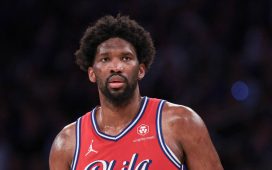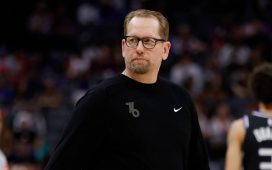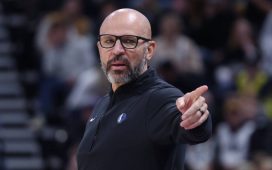Hello, and welcome to the 2022 NBA Draft Lottery! Tuesday night, the 14 teams that didn’t make the NBA Playoffs will compete in a game of chance. And by compete, I mean they have absolutely zero control over the outcome. Some teams have better odds of winning this lottery, and it’s all due to how they did in the regular season. Teams that made the Play-In Tournament but didn’t make the actual playoffs are involved. And the results of Tuesday night’s lottery could be franchise-changing for multiple organizations.
That leads to a lot of questions about what the lottery is, how it works and what’s possible in Tuesday night’s results. So I thought I’d answer any potential questions you might have if this is your first go-round with the lottery, or maybe you’re just killing time at your desk while you hover over the “minimize” option on your screen just in case your boss comes by, and you’re lamenting not being able to work from home without pants on anymore.
Let’s get to the questions and answers!
Lottery? That’s a weird word. What exactly is the draft lottery?
A lottery is defined as “a process or thing whose success or outcome is governed by chance.” Hey, that applies here!
The lottery is how we determine the order of the NBA Draft. Fourteen teams have varying chances of winning the lottery, and how it shakes out will give us what we need for the top end of the first round. Everything else in the draft from No. 15 to No. 60 is already set. Coin flips broke ties. Regular-season record settled everything else. But the lottery gives us the good stuff.
Why do we have it?
It’s to help curb tanking. Think of football, where the Cleveland Browns won one game in two seasons and ended up with the No. 1 pick in the draft each time. Was that by design? Ineptitude? Both? Regardless, if you’re rewarding a team with the top pick because it had the worst record in some vague attempt at parity, then you’re setting a bad precedent. Think of the Philadelphia 76ers back when Sam Hinkie was running things. Standings determining the entire draft would’ve been right up their alley. It could have led to even worse products than watching Henry Sims, JaKarr Sampson and Hollis Thompson leading lineups.
The lottery is supposed to add a little chance to the process and make it not so obvious who might end up with the top pick. Then, hopefully, teams aren’t throwing massive chunks of the regular season to improve their draft positions. Of course, that’s simply the theory of why it exists.
Prior to the lottery system, the NBA used a coin flip between the worst team in the West and the worst team in the East to determine the top pick. Every selection after those two teams was arranged in reverse standings order. The most famous example of that is probably the Los Angeles Lakers and the Chicago Bulls flipping for the first pick in 1979. The Lakers won and selected
How long has the draft lottery been around?
The first NBA Draft Lottery was in 1985. The New York Knicks won the inaugural lottery. They had the third-worst record in the NBA, with Golden State and Indiana tying for the worst record. Back then, the odds were even. The seven teams that qualified for the lottery each had roughly a 14.29 percent chance of taking the first pick home. Seven envelopes with team cards in them were placed in a big lottery drum, and they’d be swirled around to mix them up. Then David Stern would select the winning envelope.
The grand prize? In 1985, it was Georgetown big man phenom Patrick Ewing. He was looked at as a franchise-changing center, and magically the Knicks won the lottery. It has led to theories about a frozen envelope for Stern to feel as he pulled it out of the lottery wheel. Or maybe it was a bent envelope. There have been documentaries, theses, books, podcasts, and more created to figure out if something nefarious was at play.
The Warriors actually ended up with the seventh pick and selected Hall of Famer Chris Mullin. Indiana finished second and ended up with Wayman Tisdale. But for the Knicks to end up with Ewing was massive for the New York market and that franchise.
How does it work?
Long gone are the days of even odds for all participants. The NBA had unweighted draft lottery odds from 1985 through 1989 and then implemented the weighted system in 1990. Back then there were 66 “chances” for winning the No. 1 pick. The team with the worst record had 11 out of 66. The team with the second-worst record had 10 out of 66. And so on, and so forth. We saw the 41-41 Seattle SuperSonics move up to the second pick with just a 3.03 percent chance of getting the top spot, and they took Hall of Famer Gary Payton.
After the Orlando Magic won back-to-back No. 1 overall picks in 1992 (15.15 percent chance, second-best odds) and 1993 (1.52 percent chance, worst odds), the NBA decided to overreact and change things to an even more unevenly weighted system. The worst record went from a 16.7 percent chance of grabbing the top pick to a 25.0 percent chance. The teams with the lowest odds dropped even more, to a 0.5 percent chance. It pretty much stayed that way until 2019, when the NBA decided to legislate against the “Trust the Process” 76ers to make the lottery system less severe for odds to win it.
Now, the teams with the three worst records each have a 14.0 percent chance of obtaining the top pick in the draft. The fourth-worst record has a 12.5 percent chance of getting it. Then, with each subsequently better record from the regular season, the odds continue to drop. This is how the odds look for Tuesday night:
- Houston, Orlando, Detroit: 14.0 percent chance at top pick | 52.1 percent chance at top-four pick
- Oklahoma City: 12.5 percent chance at top pick | 48.1 percent chance at top-four pick
- Indiana: 10.5 percent chance at top pick | 42.1 percent chance at top-four pick
- Portland: 9.0 percent chance at top pick | 37.2 percent chance at top-four pick
- Sacramento: 7.5 percent chance at top pick | 32.0 percent chance at top-four pick
- LA Lakers*: 6.0 percent chance at top pick | 26.3 percent chance at top-four pick
- San Antonio: 4.5 percent chance at top pick | 20.3 percent chance at top-four pick
- Washington: 3.0 percent chance at top pick | 13.9 percent chance at top-four pick
- New York: 2.0 percent chance at top pick | 9.4 percent chance at top-four pick
- LA Clippers**: 1.5 percent chance at top pick | 7.1 percent chance at top-four pick
- Charlotte: 1.0 percent chance at top pick | 4.8 percent chance at top-four pick
- Cleveland: 0.5 percent chance at top pick | 2.4 percent chance at top-four pick
* The Lakers don’t actually get their selection. No matter where it falls in the order of the draft, they will send it to the New Orleans Pelicans as part of the Anthony Davis trade from 2019. The Lakers’ 2021 pick was protected 8-30, and if it didn’t convey to the Pelicans in 2021, it was left unprotected in 2022. So the Pelicans always knew they were getting the Lakers’ unprotected 2022 pick. They just didn’t know it would be this good.
New Orleans actually traded the pick to Memphis for Jonas Valančiūnas, but it’s top-10 protected. So three total teams with less than a 25.0 percent chance of making the top 4 in the lottery would have to win a top 4 spot in the draft to move the Lakers’ pick down to 11, which would then convey it to the Grizzlies. It would take a Memphis miracle for that to happen.
** The Clippers don’t get their selection, either. No matter where it falls in the draft, it will be sent to the Oklahoma City Thunder. It was part of the Paul George trade back in 2019 that helped them give Kawhi Leonard a running mate to join him in Los Angeles. Though technically the trade was just for George, it essentially helped them acquire George and Leonard.
There are 1,001 combinations of four ping pong balls numbered one through 14. The NBA has a random combination generated and thrown out/ignored if it comes up in the lottery drawing process. The teams with a 14.0 percent chance of winning the top pick receive 140 of the remaining 1,000 combinations. Then 125 combinations for the fourth team, and so on and so forth.
The top four picks are now drawn in the lottery (it was just the top three prior to 2019), and everything from No. 5 to No. 14 goes by regular-season standings in reverse order.
Is this the best system?
It might be! Some (like me) believe the lottery should be unweighted. If everybody in the lottery had a 1/14 chance of winning the top selection, it would theoretically end tanking for the best lottery odds. Some would then argue that a team might try to fall out of the playoff picture in order to win a lottery spot by tanking. I can’t imagine an owner would be fine with missing out on any potential playoff revenue by allowing this, and I can’t imagine players on the roster would give up a postseason appearance and bonus just so their potential replacement could be drafted with an even chance at a high selection.
Regardless, this seems to be the system moving forward.
Who are these teams hoping to get?
Check out Sam Vecenie’s Big Board so you can learn about the top draft prospect rankings. Right now, it looks like Jabari Smith Jr. (Auburn), Chet Holmgren (Gonzaga), Paolo Banchero (Duke), Jaden Ivey (Purdue) and Keegan Murray (Iowa) are going to be the biggest prizes for the lottery winning teams.
How has this new system since 2019 worked out for everybody?
In 2019, the New Orleans Pelicans and the Memphis Grizzlies had the seventh- and eighth-best chances, respectively, of winning the lottery. The Pelicans ended up with the top pick and took Zion Williamson. The Grizzlies ended up with the second pick and took Ja Morant. The Knicks had the worst record in the NBA but ended up with the third pick and RJ Barrett. The Lakers had the 11th-best odds and ended up getting the fourth pick, which was headed to New Orleans as part of the Anthony Davis trade.
Cleveland and Phoenix had the second- and third-best odds in the lottery, and they ended up selecting fifth and sixth, respectively. Chicago had the fourth-best odds and ended up with the seventh pick.
In 2020, the Warriors had the worst record in the NBA and ended up with the second pick. Minnesota had the third-worst record in the NBA and won the lottery with the top selection. Minnesota took Anthony Edwards, and the Warriors took James Wiseman. Then the Charlotte Hornets moved up from eighth to third, and they selected LaMelo Ball. The Chicago Bulls moved up from seventh to fourth to take Patrick Williams. The teams that lost out the most were the Cleveland Cavaliers, which had the second-worst record in the NB but ended up with the fifth pick (Isaac Okoro) in the draft, and Atlanta, which had the fourth-highest odds and ended up picking sixth (Okyeka Okongwu).
In 2021, things mostly went to plan with Detroit (second-worst record) getting the first pick and Houston (worst record) getting the second pick. Cleveland and OKC both shared the fourth/fifth-worst odds by splitting them, and Cleveland ended up getting the third pick (Evan Mobley), while OKC received the sixth pick (Josh Giddey). Toronto had the seventh-best odds in the lottery, but it moved up to fourth in the draft to take Scottie Barnes. The Magic were the biggest losers in the lottery by finishing with the third-worst record in the NBA but falling down to the fifth pick.
What’s the craziest jump?
Since the lottery became dramatically more weighted after the Magic got back-to-back top picks in 1992 and 1993, we’ve only seen a couple of crazy jumps.
Chicago had the ninth-best odds in the 2008 NBA Draft Lottery, and they won the No. 1 pick despite having just a 1.7 percent chance of landing it. They ended up with future MVP and hometown product Derrick Rose out of Memphis.
In 2011, the LA Clippers had the eighth-best odds in the lottery and ended up with the top pick in the draft despite just a 2.8 percent chance of receiving it. One problem with that: They’d traded the pick to the Cleveland Cavaliers at the trade deadline along with Baron Davis so they could have Mo Williams and Jamario Moon. Williams played 74 games for the Clippers over a season and a half, and the Cavs ended up drafting Kyrie Irving with the top pick.
Then again in 2014, we combined the ninth-best lottery odds and the Cavs from the two previous examples of massive jumps. With just a 1.7 percent chance of landing the top pick, the Cavs did exactly that. They ended up with Andrew Wiggins, whom they then awkwardly traded later that summer when LeBron James came to town and wanted Kevin Love to be a part of his reunion with the city. They joined Irving to eventually help the Cavs win the title in 2016.
Any predictions?
I clicked the Tankathon.com lottery simulator three times. These were the three sets of results I ended up receiving:
First Roll
Second Roll
Third Roll
- First pick: Detroit Pistons, 14.0 percent
- Second pick: Houston Rockets, 14.0 percent
- Third pick: Orlando Magic, 14.0 percent
- Fourth pick: Portland Trail Blazers, 9.0 percent
Based on those results, I will successfully predict the following top four order:
- First pick: Portland Trail Blazers, 9.0 percent
- Second pick: Orlando Magic, 14.0 percent
- Third pick: Houston Rockets, 14.0 percent
- Fourth pick: Detroit Pistons, 14.0 percent
(Photo of the 2019 NBA Draft Lottery: Patrick Gorski / USA Today)





